Local Lakes
Saturday, November 16, 2024
While visiting our area lakes formerly was an all-day task, we currently only have a few with enough water to attract migrating waterfowl, so our plan was to go to Brown’s Lake, Snyder Bend and Kramper Lake. Perhaps the most interesting, and controversial, of our finds was not waterfowl at all but a pair of hawks found before we got to our first stop.
In a field of corn stubble north of Brown’s Lake, a pair of hawks squabbled over prey caught by a very dark Buteo. This dark bird spread its wings and tail, a behavior called mantling, over the small rodent it had caught to keep the immature Red-tailed Hawk from stealing it. The feeding bird had very dark wings, back and tail and after repositioning also showed an all-dark head, breast and belly. Matching both the dark phases of Red-tailed and Rough-legged Hawk, this raptor was presenting a difficult ID challenge. Of our group, three cameras recorded the bird to aid in a later identification.
A brief stop at Brown’s Lake on this cool windy morning found only a few Ring-necked Ducks. At nearby Snyder Bend, we detected enough gulls, cormorants and pelicans to warrant a hike into the strong SE wind to the observation deck with our spotting scope. The walk produced American Tree Sparrows and from the deck we saw additional Double-crested Cormorants, American White Pelicans, Pied-billed Grebe and Ring-billed Gulls, but the expected waterfowl were largely absent save for a few Canada Geese, Mallards, three Snow Geese and two Woodducks.
A trip to Kramper Lake near Hubbard, NE, was next on our agenda with expectations that this deeper reservoir would host more diving ducks and grebes. However, upon arrival, we could immediately see that the divers that had been present the previous day were absent. Green-winged Teal, Mallard, Gadwall and Great Blue Heron were found in the shallower waters but the open water of the reservoir was empty. A hike to the nearby woods and Red Cedars found no significant birds but an interesting DeKay’s Brown Snake. These snakes are about the size of a nightcrawler and seem to be most evident in late Fall.
On our return home, eleven of us stopped at the Old Dane Golf Course clubhouse, just west of Dakota City, for lunch. In all, 19 members attended our outing with a few leaving before our enjoyable lunch.
Getting back to our unidentified hawk: Photos showed a few field marks too difficult to see in the field: a light-colored iris, indicating an immature, a few white feathers on the dark head and body and likely bright yellow tarsi (lower leg). Such legs would exclude Rough-legged Hawk and suggest the bird was either a Harlan’s or Western subspecies of Red-tailed Hawk. These two subspecies breed far to the west or north and only appear here in the winter, as they escape the colder climes of the Rocky Mountains or Far North.
For a complete list of the 35 species seen at our stops, see https://ebird.org/tripreport/293618. Additionally, roadside Mourning Dove, Horned Lark and Northern Harrier were seen by some while enroute for a grand total of 37 species.
Bill Huser, Outing Coordinator; 712-574-3107 or billfhuser@gmail.com




































All above images copyright 2024 by the respective photographers, images used with permission.
Marla & Kevin Kerr
Snyder Bend Sky
Exploring around Kramper Lake (3 images)
DeKay’s Brown Snake (2 images)
Jerry Mennenga
Dark morph Red-tailed Hawk (3 images)
Red-tailed Hawk at Brown’s Lake (2 images)
Immature Bald Eagle at Snyder Bend (2 images)
Pied-billed Grebe at Snyder Bend
Jan Null
Bald Eagle soaring over Snyder’s Bend.
Red Berries for the Birds.
Good Cover for the Birds.
Northern Flicker.
Dark-eyed Junco.
American White Pelican.
Great Egret above the Grass.
Great Egret close up.
Randall Williams
Dark morph Red-tailed Hawk with yellow lower leg
Getting the shot
Brown’s Lake sky
Immature Bald Eagle at Snyder Bend (2 images)
To the observation deck! (2 images)
Observing at the observation deck (2 images)
Snyder Bend sky
Waves at Kramper Lake
The Game is Afoot! (2 images)
Kramper Lake scenery
Below video copyright 2024 by Jan Null, used with permission.
Union Grove State Park
Saturday, October 19, 2024
Fourteen members and guests explored South Dakota's Union Grove S.P. under the expert guidance of Phil and Donna Breed. For many it was their first visit to this hidden gem, and all were impressed with the Park and its migratory birds.
Highlights included 2 Hermit Thrush seen by many, Winter and Carolina Wrens seen by the few, a Northern Shrike seen by the quick and an American Goshawk seen by the lucky. Other more common migrants, including Harris's, Song and White-throated Sparrows, Brown Creeper, Golden-crowned and Ruby-crowned Kinglets, a late Blue-headed Vireo and Orange-crowned and Yellow-rumped Warblers, were also found.
Three participants also visited Spirit Mound before returning to Sioux City, and there sightings are included in this list.
41-species; 14-participants!

































All above images copyright 2024 by the respective photographers as listed below.
Brian Hazlett
Warbler Watching
Vireo Viewing
J Murphy
American Robin
Blue-headed Vireo
Carolina Wren
Hermit Thrush
Jerry Mennenga
Golden-crowned Kinglet (3 images)
American Robin (2 images)
Fall Foliage (2 images)
Walking the Park (2 images)
Birding Break (2 images)
Kevin and Marla Kerr
White-crowned Sparrow (in-transit to Spirit Mound)
Union Grove Bird Trails (6 images)
Randall Williams
Along Brule Creek (4 images)
Photography Break at Horse Camp
Birding the Trail at Union Grove
White-throated Sparrow
Spirit Mound
Bald Eagle Aerobatics at Spirit Mound (2 images)
Fall Migratory Bird Day
Saturday, 12 October 2024
Prairie Park, Sioux City, IA
A beautiful day in Siouxland with sunshine, a few scattered clouds, and little wind. Twenty participants found 34 bird species during our time at the park to support the designation of Sioux City as a Bird Friendly Community (and have some fun birding!).The lagoon was quiet with most species found along the trails at the borders, the transitional areas between the tree lines and the prairie restoration spots.
Notable sightings include: Eastern Phoebe; Ruby-crowned Kinglet; Marsh Wren; White-crowned, White-throated, Savannah, Lincoln’s, and Swamp Sparrows; Western Meadowlark; and Tennessee Warbler.
Randy Williams
34-species; 20-participants!
Top Row: Red-winged Blackbirds, left and center; Great Blue Heron, right
Bottom Row: Lagoon trail, left and center; Red-tailed Hawk, right
Below images copyright 2024 by Randall D. Williams, used with permission.
Stone Park Fall Warbler Watch
Saturday, 14 September 2024
Patience and many sharp eyes paid off for the 22 participants of LHAS’s September outing. Spending the entire morning in the Pammel Valley portion of Stone Park in the hopes of locating migrating flycatchers, vireos and warblers, the group found little activity for the first hour but eventually located a mixed flock of songbirds high in the canopy. This flock moved slowly through the canopy as they foraged for insects but the group kept pace with them and periodically got goods looks at some of them.
Joining the expected Red-eyed, Yellow-throated and Warbling Vireos were southbound Philadelphia and Blue-headed Vireos. Flycatchers included Eastern Wood-Pewees and Great Crested Flycatcher, both summer residents here, but did not include any migrants.
Warblers highlighted the morning with Magnolia, Wilson’s, Bay-breasted, Black-and-White, Nashville and American Redstarts being seen by some of us. But, alas, none of us saw all six species of these small, flighty birds hiding among the leaves.
Other unexpected migrants included Common Nighthawk, Double-crested Cormorant, Sharp-shinned Hawk and Broad-winged Hawk.
Other species will be migrating during our next outing planned for Saturday, October 19th at Union Grove State Park. Join us as we search for them.
Bill Huser, Outing Coordinator, 712-574-3107 or billfhuser@gmail.com
All LHAS outings are open to the public and offer an inviting way to begin birding and meet others with similar interests.
42-species; 22-participants!


























Above images copyright 2024 by the photographers listed below, used with permission.
Kevin Kerr
Along the road
Park overlook
Marla Kerr
Birders at Turtle Lake 1
Birders at Turtle Lake 2
Nashville Warbler 1
Nashville Warbler 2
Elusive Philadelphia Vireo
Woodland Brown butterfly
Jan Null
Lots of Birds in there!
Maybe it’s over here?
Turkey vultures are easier to find!
White Snakeroot.
Watching for migrating raptors.
You can see a long way up here!
Randall D. Williams
Gathering of the flock
On the way to “Warbler Neck”
Phishing expedition
Road birding 1
Road birding 2
Elusive Philadelphia Vireo 1, 2, and 3
More risk of “warbler neck”
There is bird activity over there
Cleaning the used fishing line
Shelf fungus at Turtle Lake
Broken Kettle Grasslands
Saturday, august 3, 2024
66-species; 27 participants
| BIRD | BIRD | BIRDER |
|---|---|---|
| Canada Goose | Warbling Vireo | Jeanne Bockholt |
| Mallard | Blue Jay | Bill Huser |
| Rock Pigeon | American Crow | Kevin Kerr |
| Mourning Dove | Black-capped Chickadee | Marla Kerr |
| Yellow-billed Cuckoo | Cliff Swallow | Lilly Lutter |
| Eastern Whip-poor-will | Barn Swallow | Tucker Lutter |
| Ruby-throated Hummingbird | White-breasted Nuthatch | Leesa McNeil |
| Semipalmated Plover | House Wren | Jerry Mennenga |
| Killdeer | Gray Catbird | Caleb Macintyre |
| Pectoral Sandpiper | Eastern Bluebird | Bob Nickolson |
| Semipalmated Sandpiper | American Robin | Phyllis Nickolson |
| Lesser Yellowlegs | Brown Thrasher | Jan Null |
| Double-crested Cormorant | European Starling | Jon Nylen |
| Least Tern | House Sparrow | John Polifka |
| Great Blue Heron | House Finch | Sharon Polifka |
| Great Egret | American Goldfinch | Donna Popp |
| Turkey Vulture | Eastern Towhee | Jerry Probst |
| Cooper's Hawk | Field Sparrow | Maria Rundquist |
| Red-tailed Hawk | Lark Sparrow | Rex Rundquist |
| Barred Owl | Grasshopper Sparrow | Anne Shaner |
| Yellow-bellied Sapsucker | Western Meadowlark | Ed Sibley |
| Red-headed Woodpecker | Eastern Meadowlark | Jane Sibley |
| Red-bellied Woodpecker | Orchard Oriole | Jerry VonEhwegen |
| Downy Woodpecker | Baltimore Oriole | Randy Williams |
| Hairy Woodpecker | Red-winged Blackbird | Eric Wissing |
| American Kestrel | Brown-headed Cowbird | Bill Zales |
| Eastern Wood-Pewee | Common Yellowthroat | Dotty Zales |
| Eastern Phoebe | American Redstart | . |
| Great Crested Flycatcher | Yellow Warbler | . |
| Western Kingbird | Northern Cardinal | . |
| Eastern Kingbird | Rose-breasted Grosbeak | . |
| Bell's Vireo | Blue Grosbeak | . |
| . | Indigo Bunting | . |
| . | Dickcissel | . |










































Above images copyright by the respective photographers as listed below, used with permission.
Kevin Kerr
Along Lineberry Lane
Prairie Hills (2 images)
Marla Kerr
Road toad
Prairie explorers
Prairie parasols
Modern rustic
Let’s eat!
Prairie Hills guides
Tucker Lutter
Posing on the prairie
Along Butcher Road
Prairie Hills
Prairie rest stop
Jan Null
Welcome to Broken Kettle’s Loess Hills.
Big Bluestem overlooking the Hills.
Grazing Bison. LHASOuting
Looks like a dead branch.
There’s a Red-tailed Hawk on that log!
Gateway to the Prairie.
Partridge Pea along the road.
A Grasshopper Sparrow enjoying the view.
Birders ready for lunch!
Posing after lunch.
Can you see the Yellow-bellied Sapsucker?
Homemade Ice cream!
Randall D. Williams
Looking for the Little Blue Heron
E C Lippke Wetlands
Flood aftermath (2 images)
Lineberry Lane
Where are the cuckoos?
Yellow-billed Cuckoo
Dragonfly
Broken Kettle Bird Conservation Area
Bison
Jerry Mennenga (7 images)
Below video copyright 2024 by Jan Null, used with permission.
Birds of Summer Double-Header
Saturday, July 13, 2024
Adams Homestead
The original LHAS July outing was intended to visit the Nebraska Sandhills in and around Valentine, NE. Plans did not work the way we wished but that allowed today’s double-header of summer activities.
At Adams Homestead, seven intrepid birders and one late-arriving participant braved the insects, heat and humidity for a walk around the Homestead area, the Donkey Run trail, an overview of Mud Lake, and the water fountain oasis at the visitor center. We found 29-species, all typical summer residents of the Homestead and Preserve.
Randy Williams
| BIRD | BIRD | BIRD | BIRDER |
|---|---|---|---|
| Wood Duck | Blue Jay | American Goldfinch | Sarah Hubert |
| Mourning Dove | Barn Swallow | Orchard Oriole | Kevin Kerr |
| Chimney Swift | White-breasted Nuthatch | Red-winged Blackbird | Marla Kerr |
| Great Blue Heron | House Wren | Brown-headed Cowbird | Jerry Mennenga |
| Turkey Vulture | Brown Thrasher | Common Yellowthroat | Grace Perrin |
| Red-headed Woodpecker | Eastern Bluebird | Northern Cardinal | Rex Rundquist |
| Northern Flicker | American Robin | Rose-breasted Grosbeak | Todd Wheelock |
| Eastern Kingbird | House Sparrow | Indigo Bunting | Randy Williams |
| Warbling Vireo | House Finch | Dickcissel | . |







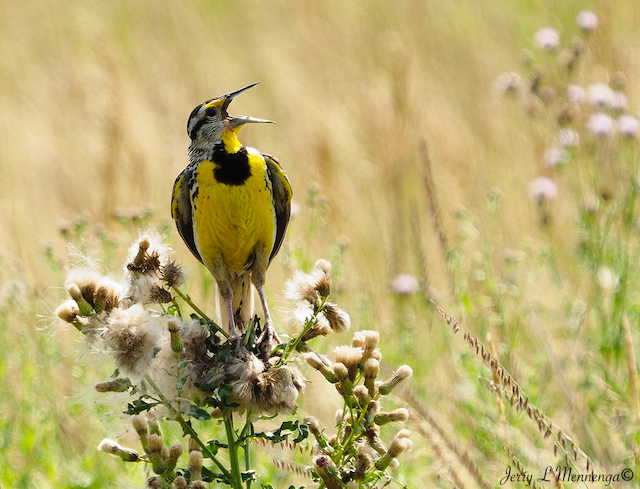




Above images copyright 2024 by the respective photographers as listed below, used with permission.
Kevin & Marla Kerr
Donkey Run Trial
Trailside attraction
Looking for birds (2 images)
Randall D. Williams
Eastern Bluebird
Turkey near the Homestead
Jerry L. Mennenga
Fawn
Eastern Meadowlark
Northern Flicker
Mourning Dove
Heat relief (2 images)
Zales’ Prairie
Due to heat, humidity and temperatures in the mid-90s, the walk at Five Ridge Prairie was moved to the Zales Guest House. In the wonderfully air conditioned Guest House, Bill Zales gave an entertaining presentation to a captivated audience of 21 people, focusing on history.
Because it was Bill Zales, it was the history leading to the current situation and where we are now with our remaining native prairies. He started at the beginning with the original continent and the break up. Then he discussed major impacts in the earth's history. Along the way, there was a pop quiz, answered by Maria Rundquist, on the location of the asteroid hit that wiped out the dinosaurs: the Yucatan Peninsula in Mexico, at a location known as the Chicxulub crater.
He discussed the prairies and the climate that formed them in broad terms, and then lamented on the intrusion of humans and the ruining of this landscape. We lamented this loss together. But there was inspiration there as well; there is Zales’ Prairie and awareness is being raised.
Among the attendees were four DNR Surveyors who were very involved from beginning to end. After the talk, there was a walk — in spite of the heat — for the hardy souls who choose to do it. Bill discussed what has happened with the property on which we walked, how it has changed and why. As usual he was a thoroughly entertaining guide to the plants.
Good Company, Good Prairie and Good Education was had by all.
Kevin and Marla Kerr












Above images copyright 2024 by the respective photographers as listed below, used with permission.
Dawn Snyder
Guest House
Marla & Kevin Kerr
Bill Zales
Field trip
Compass Plant
Out in the field
Wildflower group
Prairie progress
More wildflowers
Quick stop
Common Whitetail
Barn craft
Cooling on the porch
Adams Homestead and Nature Preserve
Monday, June 10, 2024
After a series of scheduling conflicts, the LHAS June outing was moved from the traditional second Saturday of the month to the following Monday to join a bird walk at Adams Homestead led by Jody M., Maddi K., Grace, and Randy W. at 9:30 AM. Migrating birds have passed through, so this walk’s participants found summer resident species and noted evidence of their breeding activities.
In all, 39 species were recorded, including both Eastern and Western Meadowlarks, Indigo Bunting, Eastern Wood Pewee and many Baltimore Orioles, Red-headed Woodpeckers and four species of swallows. Nesting of Wood Ducks, Eastern Kingbirds, Tree Swallows and Common Grackles was confirmed. Three broods of downy, fledgling Wood Ducks totaled an amazing 26 cuties, while both the kingbird and grackle were seen carrying food to their young. Several other species were noted as probable nesters with paired male and female present. These included Baltimore Oriole, Red-winged Blackbird, Brown-headed Cowbird and Barn Swallow.
Participants: Jody Moats, Randy Williams, Marla & Kevin Kerr, Jon Nylen & Leesa McNeil, Phil Breed, Jerry Mennenga, Kyle Schmidt & kids, Kathy Pfautch, park naturalists Grace and Maddi, and members of the public, totaling 16 adults and 7 children, in all.
Bill Huser, Outing Coordinator
Species: 39 total
See below or go to eBird: https://ebird.org/tripreport/251315 for a complete list of species.
| BIRD | BIRD | BIRD |
|---|---|---|
| Canada Goose | Red-eyed Vireo | House Finch |
| Wood Duck | Blue Jay | American Goldfinch |
| Ring-necked Pheasant | Black-capped Chickadee | Song Sparrow |
| Mourning Dove | Bank Swallow | Western Meadowlark |
| Turkey Vulture | Tree Swallow | Eastern Meadowlark |
| Red-headed Woodpecker | Northern Rough-winged Swallow | Baltimore Oriole |
| Red-bellied Woodpecker | Barn Swallow | Red-winged Blackbird |
| Downy Woodpecker | White-breasted Nuthatch | Brown-headed Cowbird |
| Hairy Woodpecker | House Wren | Common Grackle |
| Northern Flicker | Eastern Bluebird | Yellow Warbler |
| Eastern Wood-pewee | American Robin | Northern Cardinal |
| Eastern Kingbird | Cedar Waxwing | Indigo Bunting |
| Warbling Vireo | House Sparrow | Dickcissel |

















All above images copyright 2024 by the respective photographers listed below, used with permission.
Jerry L. Mennenga - 10 images
Leading the charge!
House Finch
White-breasted Nuthatch
eBird documentation
Eastern Meadowlark
Eastern Meadowlark (left) and Cedar Waxwing (right)
On the move
Swallowtail
Getting the photo
Consultation
Randall D. Williams - 7 images
Looking for a Cooper’s Hawk nest
Swallowtail
Donkey Run Trail
Edge of the lake
Bird finding
Eastern Meadowlark (2 images)
2024 BIRDATHON! and World Migratory Bird Day
Saturday, May 11, 2024
The Loess Hills Audubon Society recently held its annual Birdathon to raise funds for Chapter projects. Much like other “-athons,” donations are pledged based on chapter members’ ability to find as many species of birds as they can on Saturday, May 11.
All in all, 9 teams, representing 15 Chapter members, turned in their findings. The 8 teams searching 5 local counties, and 3 states, found a total of 143 species, while an additional team birding in Nevada found an additional 14 species for a grand total of 157 species. These two totals compare with results of the past few years.
This year one team invited new members and the public to join them at Prairie Park as part of a Chapter outreach and Bird Friendly City event. A total of 14 people visited during the 9:00 AM to Noon event. Three children and five accompanying adults participated in a Bug Hunt led by Kari S. from Dorothy Pecaut Nature Center.
For a complete species list see: https://ebird.org/tripreport/238829
Now, the critical portion of the project:
Each participant/team is requested to collect all their pledged donations and send them to me.
Each donor who pledged a donation is requested to forward it to your team or directly to me.
Each additional person who would like to donate to the Chapter’s projects is asked to send an amount based on the number of species found or a flat amount of your choosing.
Note: Please make checks payable to ‘Loess Hills Audubon Society’ and designate the check as ‘Birdathon.’
Most importantly, THANK YOU to everyone who has donated to Chapter projects and to those of you who considered such.
Bill Huser, LHAS Outings Coordinator & Birdathon Czar, 140 Oakmont Drive, South Sioux City, NE 68776; 712-574-3107 or billfhuser@gmail.com
| BIRD | BIRD | BIRDER |
|---|---|---|
| Hooded Merganser | California Quail (NV) | Bill Huser |
| Northern Bobwhite | Western Grebe (NV) | Kevin Kerr |
| Eared Grebe | Calliope Hummingbird (NV) | Marla Kerr |
| Sora | Piping Plover | Bob Livermore |
| Upland Sandpiper | Hudsonian Godwit | Amy Marincic (NV) |
| Willet | Ruddy Turnstone | Leesa McNeil |
| Sanderling | Dunlin | Bob Nickolson |
| Least Tern | American White Pelican | Phyllis Nickolson |
| Great Egret | Osprey | Jan Null |
| Swainson's Hawk | Pileated Woodpecker | Jon Nylen |
| Western Wood-Pewee (NV) | Willow Flycatcher | Kathy Pfautch |
| Bell's Vireo | Yellow-throated Vireo | Pam Pfautch |
| California Scrub-Jay (NV) | Black-billed Magpie (NV) | Donna Popp |
| Mountain Chickadee (NV) | Bewick's Wren (NV) | Jerry Probst |
| Sage Thrasher (NV) | Gray-cheeked Thrush | Anne Shaner |
| Wood Thrush | Lesser Goldfinch (NV) | Jerry Von Ehwegen |
| Grasshopper Sparrow | Clay-colored Sparrow | Randy Williams |
| White-crowned Sparrow | Bullock's Oriole (NV) | Dotty Zales (NV) |
| Northern Parula | Magnolia Warbler | . |
| Louisiana Waterthrush | Wilson's Warbler | . |
| Scarlet Tanager | Wester Tanager (NV) | . |
| Black-headed Grosbeak (NV) | Blue Grosbeak | . |


















Above images copyright 2024 by the respective photographers as listed below, used with permission.
Marla & Kevin Kerr
Welcome Station
Self-professed “Bird Nerd”
Observation List
Shelter activities
Observations 1
Observations 2
Shelter list
Insect preparation
Randall D. Williams
Edge of the park
Pond 1
Pond 2
Large-mouth Bass
Prairie Park Parking
Pollinator Prairie
Eastern Kingbird
Ruddy Duck
Robin family
Red-tailed Hawk
Storm Lake
Saturday, April 13, 2024
A relatively short drive to the east transported our group to a quite different world, hydrology speaking. The Des Moines lobe of the Wisconsin Glacier covered central Iowa and points north 10,000 years ago. As this huge glacier melted and retreated northward, it left countless pothole lakes and marshes across Minnesota, Wisconsin, much of the Dakotas and North Central Iowa. Storm Lake and Kiowa Marsh, a mere 65 miles away, are such ‘potholes.’ In addition to this geologic difference, the area has not experienced the extended drought as most of us have. These potholes are brimming with water.
Our first stop was to meet up with our local guide, Dana Siefer of Storm Lake, in Early, IA. Two miles to the east, lying between the old US-20 and the new, lies Kiowa Marsh. We have all driven right by this gem, but few of us have stopped. Our time spent here showed what a mistake that has been. The parking lot for this state WMA is surrounded on all sides by water and was teaming with all the common species of waterfowl we could expect. Close views, in excellent light, of Northern Shovelers, Blue-winged Teal, Green-winged Teal, American Wigeons, Wood Ducks, Redheads, Lesser Scaup, Ruddy Ducks and others were easy to obtain. Some other species, such as Trumpeter Swans, Yellow-headed Blackbirds, Great Egrets and Great-tailed Grackles were evidence of the value of these pothole marshes. In the coming weeks the marsh will see the influx of much more: herons and egrets, Soras and Virginia Rails, Swamp Sparrows and Marsh Wrens and many others. At other access points we saw Northern Harrier, Red-tailed Hawks and a Bald Eagle.
Later stops at Burrow’s Pond and a gravel pit showed us more waterfowl and Ring-billed Gulls, Belted Kingfisher and Hooded Mergansers. Our next stop at Storm Lake’s Wastewater Treatment Plant (WWTP) was to view gulls and shorebirds through their chain link fence. However, an understanding employee opened the gate for us so we could more closely study Ring-billed, Franklin’s and probable Bonaparte’s Gulls, Greater White-fronted Geese, more ducks and 25 unexpected American Golden-Plovers. Afterwards, empty stomachs prevailed in some, and the party split to go to lunch or Little Storm Lake. I cannot attest to the lunch, but many more ducks, including Canvasbacks, Cormorants and Bonaparte’s Gulls awaited us at LSL. On the big lake Dana re-found some Greater Scaup for us as we relaxed in 79 degree sunshine. The remaining stomachs were beckoning by then, so the holdouts checked in with the lunch crowd and found our own lunch to end this beautiful day.
Participants: John and Sharon Polifka, Rex and Maria Rundquist, Jerry Probst, Bill Huser and Dana Siefer.
Bill Huser, Outing Coordinator
Below images and video copyright 2024 by Maria Rundquist, used with permission.












Marsh Madness
Sunday, March 17, 2024
A traditional waterfowler’s experience – a trip to a blind for up close views and photo opportunities of migrating swans, geese, ducks and others- at Ponca State Park was planned.
At our 3:30 PM Sunday meeting time, the temperature was only 34 degrees and NW winds howled at 35mph. No participants braved the conditions, so leaders Ed Brogie and Bill Huser cancelled the outing.
Bill Huser, Outing Coordinator
2024 Great Backyard Bird Count
FEBRUARY 17, 2024
Waterman Creek Area
Saturday, 27 January 2024
The participants of our January outing had to endure most of the challenges of winter birding: one postponement, a foggy drive, light snow, low bird activity and closed facilities.
But in spite of the above, ten LHAS members met up with Dana Siefer of Storm Lake, our guide for the day, to start our tour of the Waterman Creek Area of O’Brien County, Iowa. This area includes the flowing waters of the Little Sioux River, and the Waterman and Mill Creeks, large Eastern Red-Cedar woods and open expanses and is known to attract wintering birds from the surrounding areas but also from the Rocky Mountains and Northern Boreal Forests.
Dana first took us to an uninhabited farmhouse with well-stocked feeders. There we found most of the common feeder visitors plus a wintering Mourning Dove and a flock of a dozen or so Pine Siskins. The Siskins are a species that irrupts from its usual winter range in the North and spreads more widely and appears here some winters. Continuing down this same road, we next located Red-tailed Hawks and a lone Northern Shrike. The Shrike, also known as the Butcher Bird, is our smallest full-time predatory bird and specializes in taking small rodents and song birds to survive the winter.
After these finds we moved closer to the large Eastern Red-Cedar woodlands which both shelter and feed large numbers of birds. Though we could find very few American Robins and Eastern Bluebirds feeding on the small blue Cedar berries, we could not locate any Cedar Waxwings or Purple Finches. We did, however, find an even more elusive berry eater, a Townsend’s Solitaire, which may have come from as far away as the Rocky Mountains.
Covering more area northward, we found several Bald Eagles but could not find the Golden Eagle that had been in the area. A Rough-legged Hawk was located nearby after we started for home.
Altogether, we recorded 25 species of birds as we searched for these more unexpected species. We also introduced several people to the Waterman Creek Area where they may someday return during winter or other seasons. For a complete list of the birds recorded, see: https://ebird.org/tripreport/198463.
Participants: Bill & Dotty Zales, John & Sharon Polifka, Marla & Kevin Kerr, Randy Williams, Bob Livermore, James Bailey, Bill Huser and Dana Siefer.
| BIRD | NUMBER | BIRD | NUMBER | BIRDER |
|---|---|---|---|---|
| Ring-necked Pheasant | 20 | Black-capped Chickadee | 3 | James Bailey |
| Rock Pigeon | 8 | European Starling | 65 | Bill Huser |
| Mourning Dove | 1 | Eastern Bluebird | 10 | Kevin Kerr |
| Bald Eagle | 5 | Townsend's Solitaire | 1 | Marla Kerr |
| Red-tailed Hawk | 4 | American Robin | 1 | Bob Livermore |
| Red-bellied Woodpecker | 3 | House Sparrow | x | John Polifka |
| Downy Woodpecker | 3 | House Finch | 1 | Sharon Polifka |
| Hairy Woodpecker | 1 | Pine Siskin | 12 | Dana Siefer |
| Northern Flicker | 3 | American Goldfinch | 3 | Randy Williams |
| Northern Shrike | 1 | American Tree Sparrow | 60 | Bill Zales |
| Blue Jay | 6 | Dark-eyed Junco | 28 | Dotty Zales |
| American Crow | 25 | . | . | . |
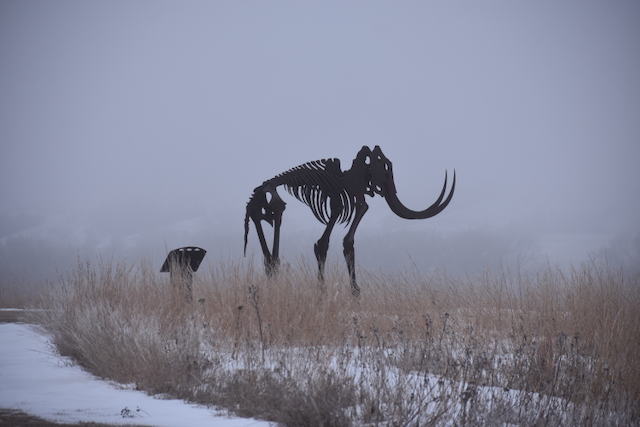
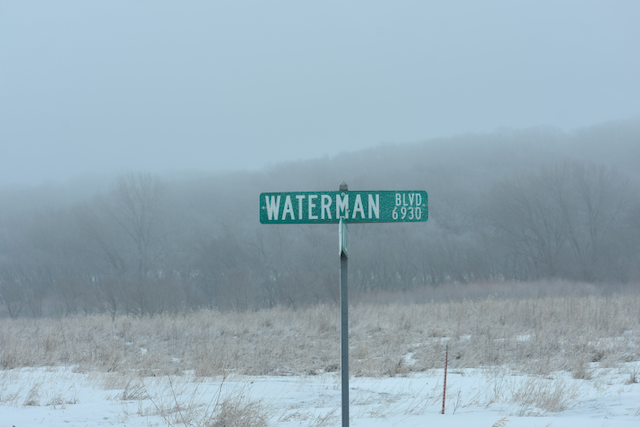
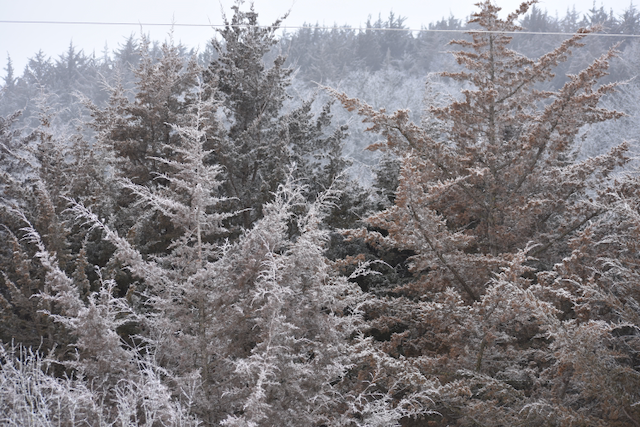
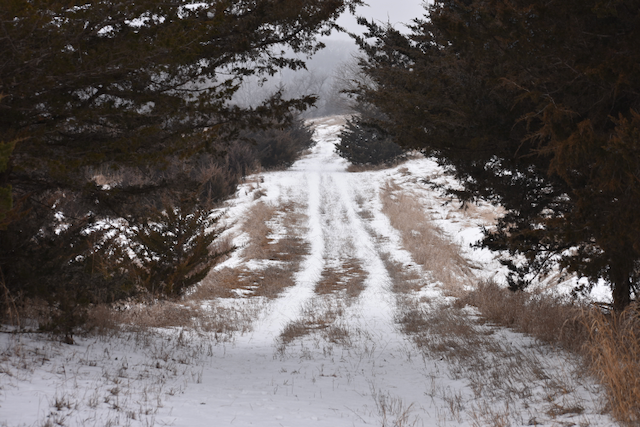
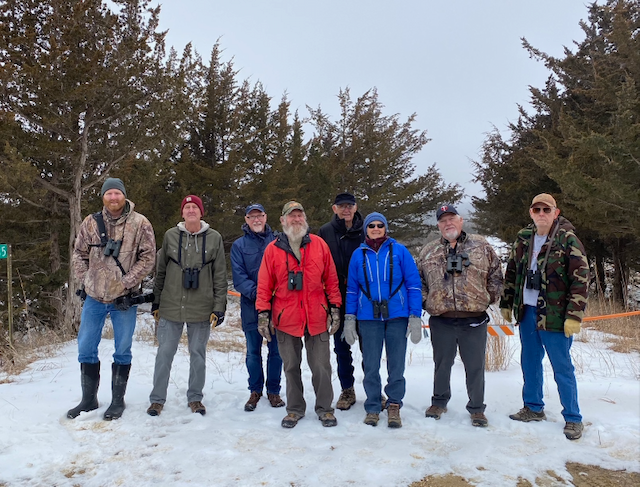
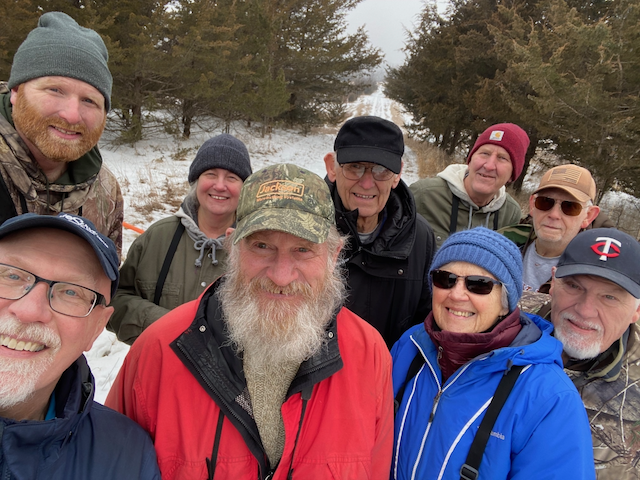
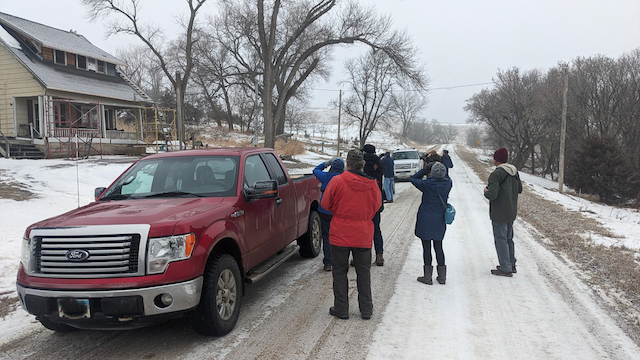
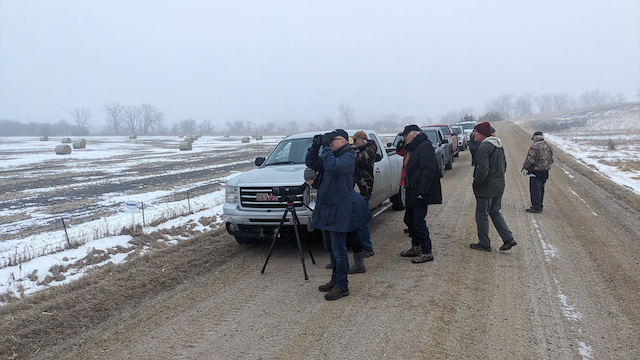
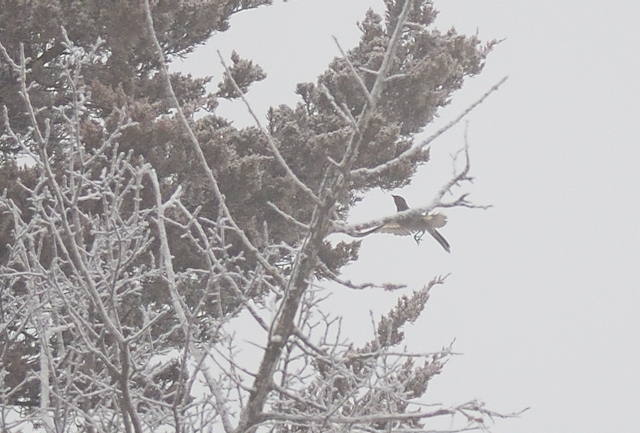

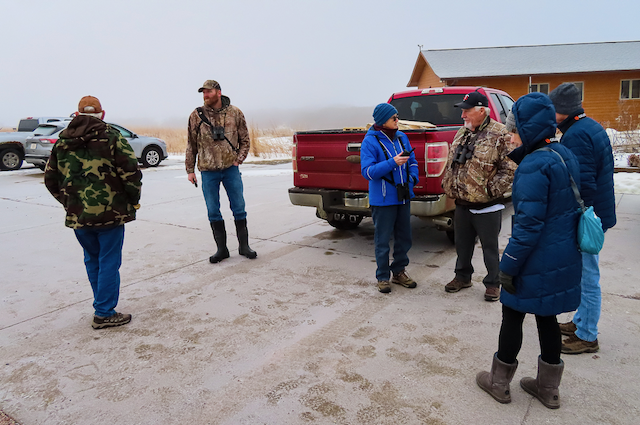

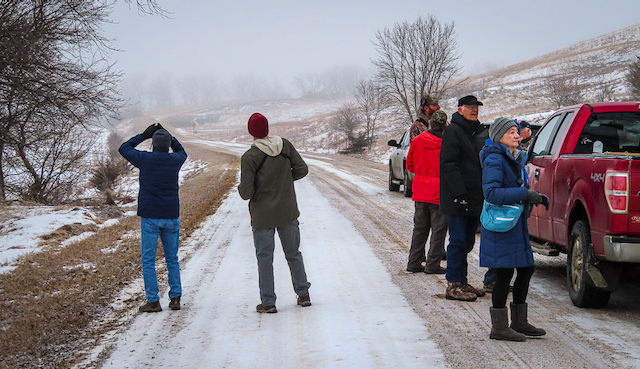
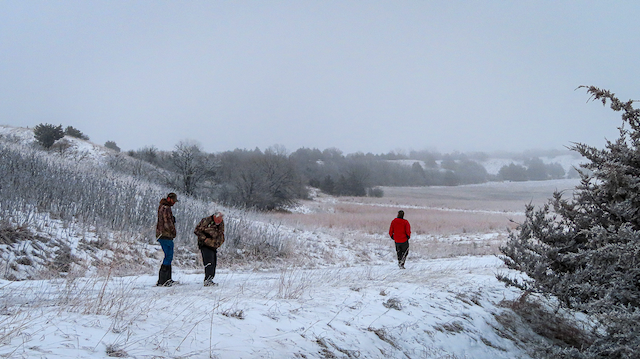
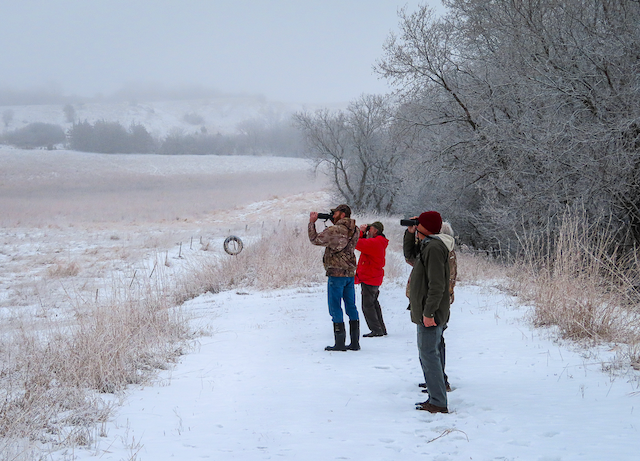

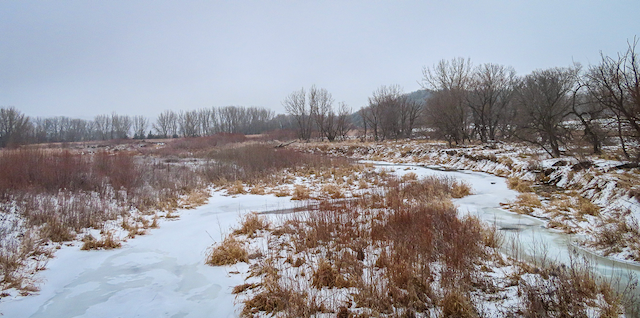
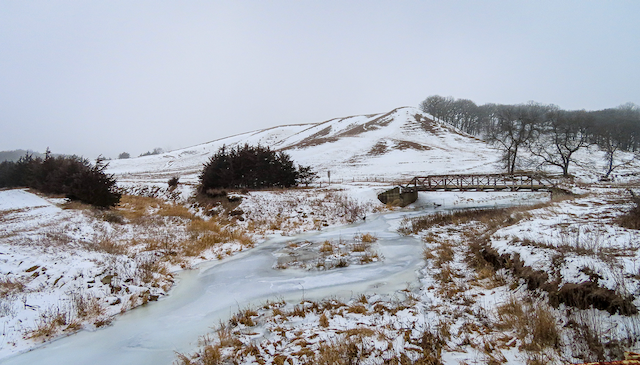
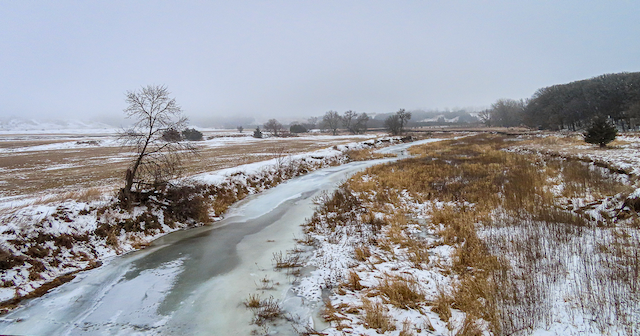
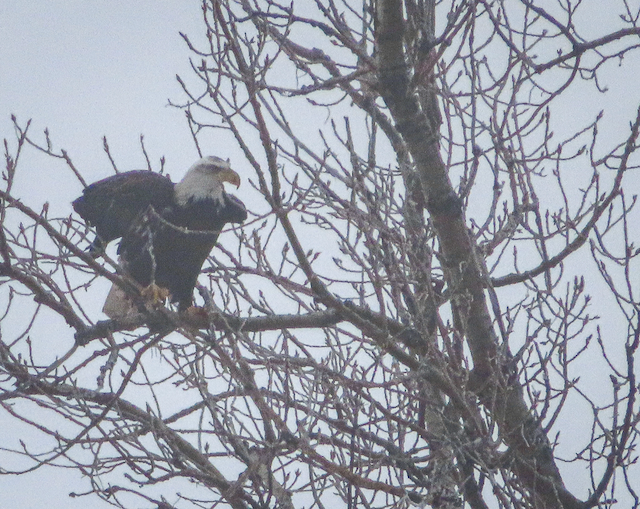
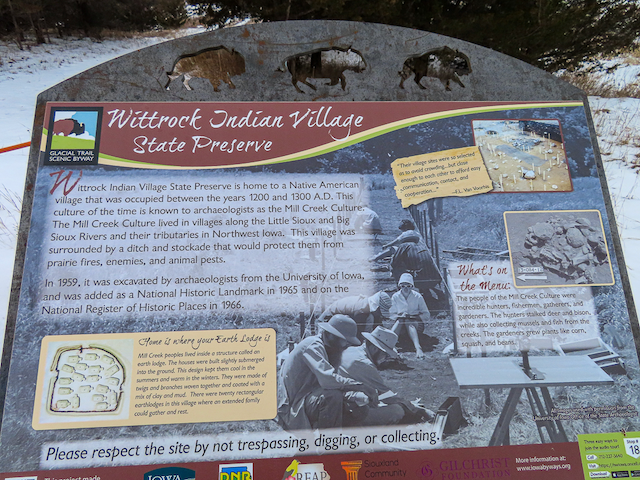
All above images copyright 2024 by the respective photographers as listed below.
Marla & Kevin Kerr
Mammoth in the mist
Waterman Creek
Tree frosting
Walkway
Birders of the day! (Photo by Marla)
Group selfie!
Dana Siefer
Stopping for siskins!
Shrike patrol!
Birders of the day! (Photo by Dana)
Randy Williams
Gathering at the Prairie Heritage Center
Pine Siskin
Plenty of winter finches
Looking for the solitaire (3 images)
Waterman Creek snowscapes (3 images)
Bald Eagle
Wittrock Indian Village State Preserve












